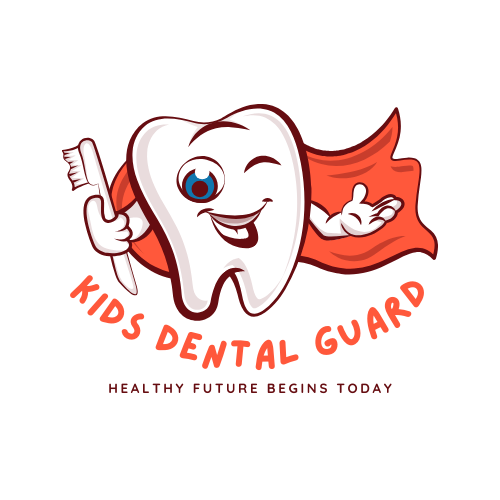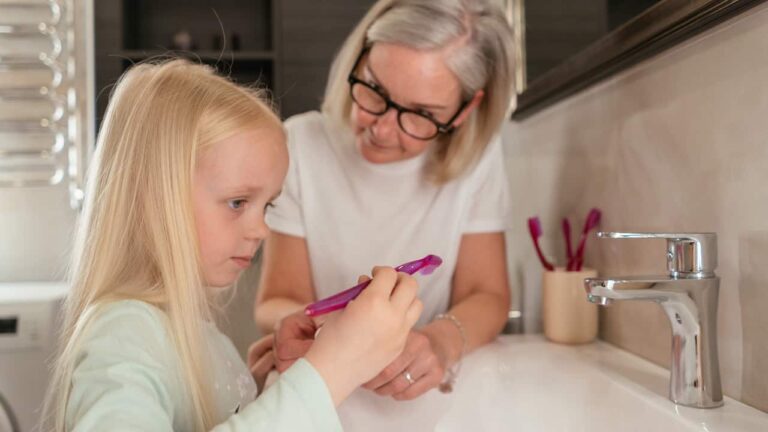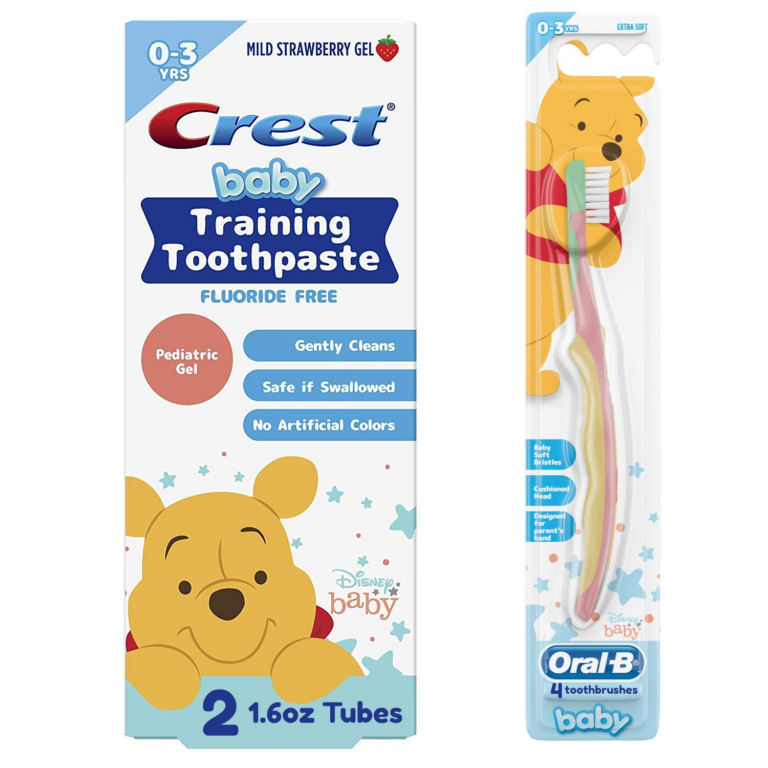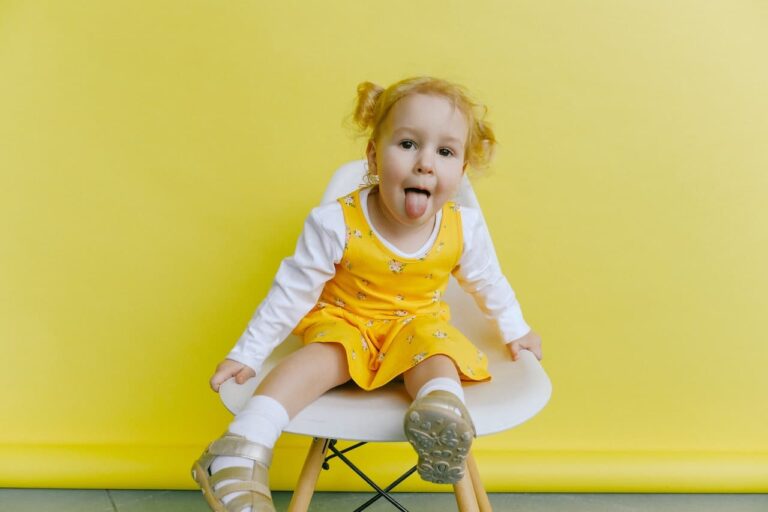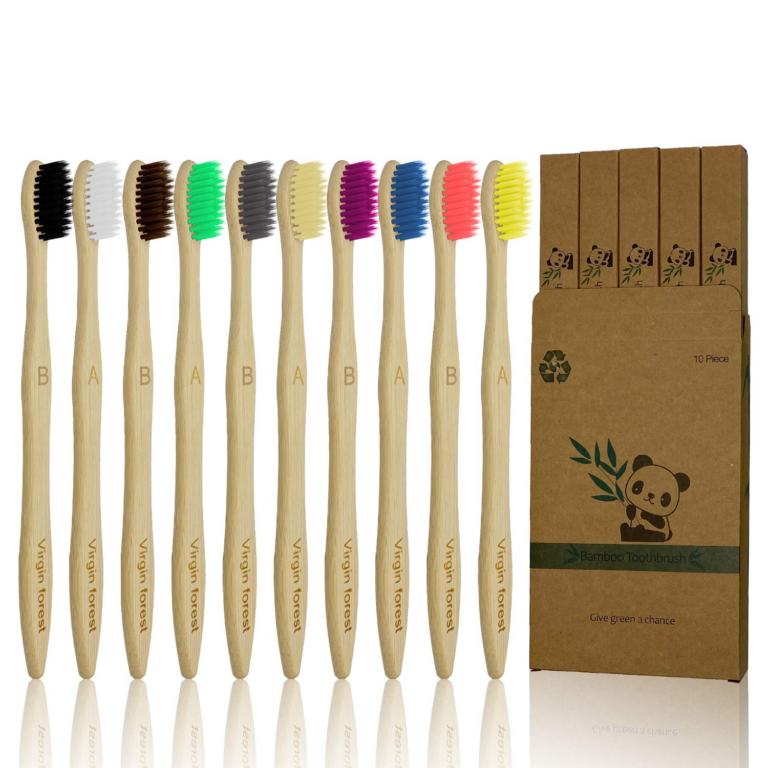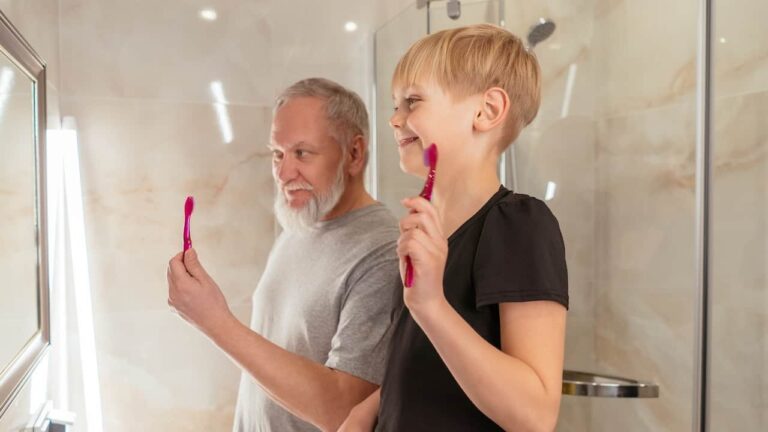Ultimate Guide to Brushing Kids’ Teeth
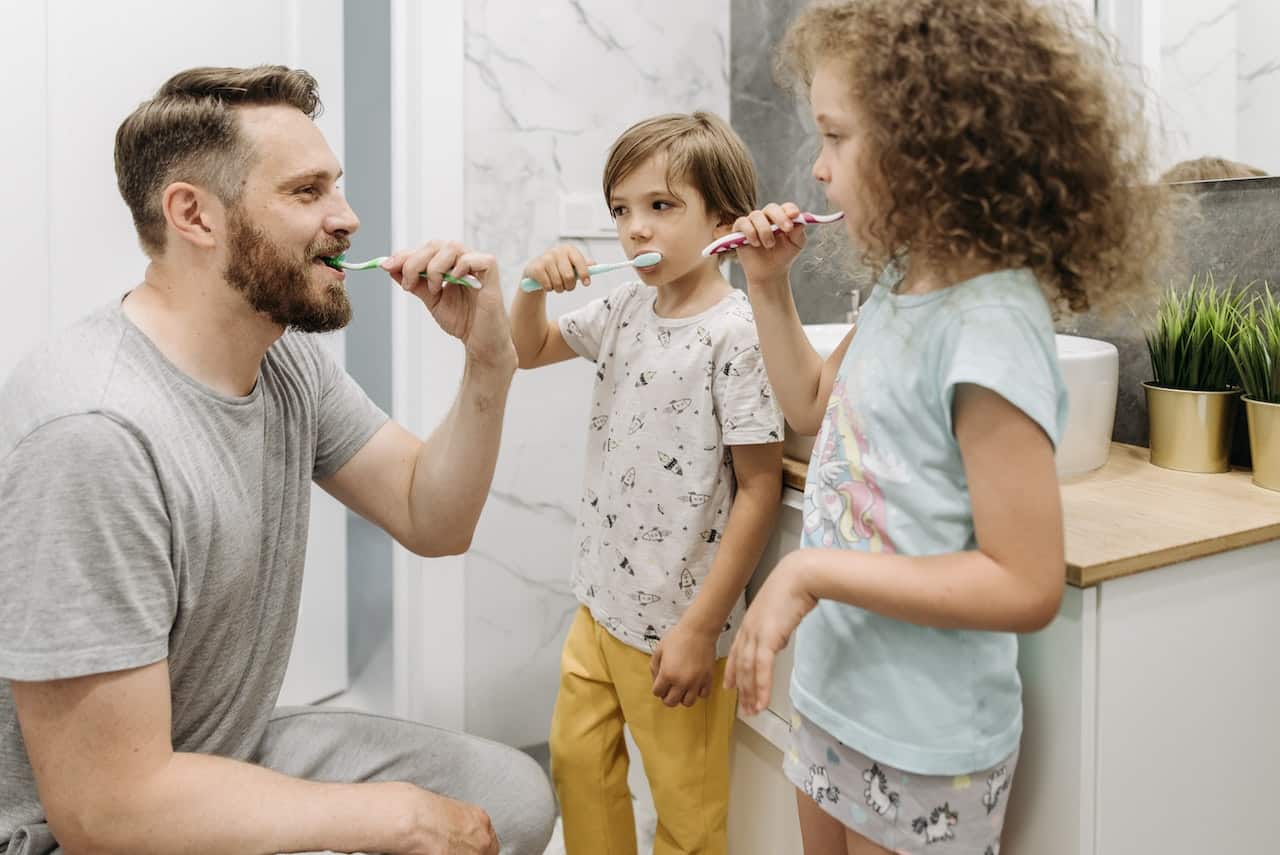
Parenthood can be a sweet, wild ride. Don’t you just love seeing those smiling faces of your babies every day?
Cherish this time because time flies by so quickly. As your baby grows, you will add more items to your list to worry about. One of them is dental health.
Cavities and plaque are never good news. As a parent, it’s your responsibility to help them indulge in proper dental hygiene.
Unable to follow proper oral hygiene can result in a fussy child and hefty dentist fees.
In this blog, we have provided a detailed guide on how you can help your child brush their teeth.
Let’s dive in.
Why Is Brushing Baby Teeth Essential?
Isn’t it exciting to witness your child’s first tooth break through the gums?
But now, you need to take care of these teeth. Dental care must begin as soon as the first milk tooth shows.
A baby’s first tooth comes out of the gum when they are around 6 months old. Even though the teeth are not permanent and fall later, it’s still imperative to take appropriate care of them to prevent oral health issues like plaque buildup.
Children as compared to adults are more at risk for oral problems like cavities. Cavities if not caught early can do long-term damage to the baby’s oral health. In some cases, it may lead to growing crooked and unaligned adult teeth.
Things You Will Need To Help Your Child Start Brushing
Following are some basic yet essential types of equipment that you should use to take good care from an early stage of parenting.
1. Brush
Of course, the brush is an integral part. Brushing teeth is not necessary for newborns. The correct time for you to start brushing your kid’s teeth is when the first teeth start to appear.
The American Academy of Pediatric Dentistry (AAPD) report recommends that you should clean the baby’s gum with a clean and wet cloth or finger brush. This will help them to disturb the bacterial plaque.
When your baby’s teeth come out completely, you purchase a new toothbrush for them.
Always make sure that the age group mentioned on the toothbrush pack should match your kid’s age. Recommended brushes for babies include soft bristles with a small head and easy-to-grab handles.
However, the important thing to remember is that the brush should be changed every three months.
2. Floss
Flossing your kid’s teeth is vital and part of the dental health routine. But, many people ignore flossing completely!
Brushing alone isn’t helpful in removing all the plaque on your kid’s teeth. Flossing is critical because the brush cannot reach all the corners of your child’s teeth. That’s where dental floss helps clean the hard-to-reach places between their teeth.
You can start to floss your child’s teeth when two of their teeth start touching. For children, it should begin around 2-3 years old.
Getting started with flossing at an early age will help to keep the dental problem away for a long time.
Flossing is the only way to get rid of food particles stuck between teeth. Removing food between teeth is essential to prevent several dental problems, like cavities, bad breath, and gum disease.
You may have trouble using the traditional flossing technique for kids. To avoid such issues, you can try floss picks made for children. They are kid-friendly, easy to handle and come with different toy shapes that kids love.
Some of the popular children’s flossers are as follows:
- GUM-897 Crayola Kids’ Flossers, Grape
- MinLan Kids Dental Floss
- Piico Dental Floss Pick
- DenTek Kids Fun Flossers
3. Toothpaste
Like toothbrushes and flossers, toothpaste plays a vital role in dental hygiene. It helps minimize the amount of bacterial plaque on your teeth with unique formulas.
However, it’s essential to understand that not all toothpaste is created equal. Some are too strong for children’s sensitive teeth.
And since very young babies are incapable of spitting out the toothpaste, it is always a good idea to start your child on fluoride-free toothpaste. That is also totally void of parabens, phthalates, and petrochemicals, making it completely safe if swallowed.
As your child approaches the age of three, you can gradually increase the toothpaste quantity. Fluoride, an active element in toothpaste, is frequently added to children’s toothpaste to protect their teeth against caries. For children under the age of six, this is especially important.
Several children’s toothpaste is enriched with kid-friendly flavors to encourage brushing.
Choose a favorite of your child’s. Look for toothpaste that holds the American Dental Association’s (ADA) Seal of Acceptance. It indicates that the toothpaste complies with the American Dental Association’s (ADA) safety and efficacy standards.
Last but not least, read the manufacturer’s label. Some toothpaste is not suitable for children under the age of eighteen.
Popular kid’s toothpaste is mentioned below:
- Aquafresh® Bubble Mint Toothpaste
- Colgate® Kids’ Mild Bubble Fruit Flavor.
- Crest® Kids’ Cavity Protection Toothpaste
How To Brush Your Child’s Teeth?
Brushing a child’s teeth is an entirely different experience! Helping your kid become accustomed to having a toothbrush in their mouth twice a day is a vital first step in developing a decent oral hygiene habit, so make it a joyful experience from the start.
Children like experimenting with new things. It doesn’t have to be as scientific and detailed as your brushing routine when you first start.
Allow your child to handle a toothbrush, play with it, and attempt to clean their teeth to make the procedure more enjoyable for them. Your child will begin to enjoy it after a while.
Below are the tips for brushing your baby’s teeth.
1. Brushing For Babies
After feeding your baby, gently wipe your baby’s gums with a clean, wet washcloth or a finger toothbrush.
Set an objective of doing this twice a day, similar to how you would brush your teeth.
Switch to a soft-bristled toothbrush made for babies and toddlers once your baby gets their first tooth.
Most dentists advise that you maintain cleaning your baby’s gums until more teeth emerge during this period. As your baby’s teeth erupt, continuing to scrub his or her gums might help relieve discomfort.
Here are some tips for brushing your baby’s teeth.
- Brush your baby’s teeth more thoroughly over time, being sure to cover all of the surfaces. Do it at least twice a day, shortly before bedtime, and at a time that works for you.
- Your baby’s gums are sensitive, so try soft clothes with a gentle touch.
- Since babies would fuss, while you clean their gums, you may have to keep patience.
- Brushing a baby’s teeth is simplest if you place them on your knee with their head on your chest. Stand behind an older youngster.
2. Brushing For Toddlers
Brushing a toddler’s teeth is a hard task. Toddlers like asserting their newfound freedom in practically any environment.
In order to help them succeed, it is important to establish a pattern and a few pointers. Most experts advocate brushing younger children on the floor like you would with a newborn.
Following are some tips for you to brush your toddler’s teeth.
- Choose a soft-bristled toothbrush with a tiny head. This will fit better in their mouth and will be gentler on their teeth and gums as they mature.
- Dentists recommend brushing toddlers’ teeth twice a day, once before breakfast and once before bedtime.
- Use the smallest bit of fluoride toothpaste you can find, around the size of a grain of rice. You may raise this quantity to the size of a pea as your child grows older, gains more teeth, and improves at spitting the toothpaste out.
- Brush for two minutes in back and forth, vibrating motions.
Best First Brushes For Kids
Are you curious to know about the best toothbrushes for your toddlers?
Fortunately, the market provides many options for child toothbrushes. To help you, we’ve put together a list of the three best children’s toothbrushes of a different kinds.
The Soobei Kids U-shaped toothbrush is manufactured of food-grade silicone for a safe and comfortable brushing experience for your child. It’s good, a brush for your kid if they don’t like the normal brushes.
The brush is available in two sizes. One is for children aged 2 to 6, while the other is for children aged 6 to 12.
Because the handle is sturdy, it won’t break easily. Furthermore, as compared to ordinary brushing, the 360 brush cleans every portion of the child’s mouth.
Need an eco-friendly option for your child’s toothbrush? If yes, then a Bamboo brush is the right choice. Bamboo toothbrushes for kids are created from organically grown bamboo, which is naturally stronger than wood, biodegradable, and long-lasting.
Food coloring dye is used to color the bristles and handles, which is non-toxic, eco-friendly, and safe for your babies and toddlers.
Unlike typical flat-handled toothbrushes, this kid bamboo toothbrush has a spherical handle that is easier to hold for small hands. Different colors make it easy to distinguish which brush belongs to whom.
The Oral-B Kids Electric Toothbrush comes with a rechargeable handle and charger, as well as around, extra-soft brush head, and a gentle mode designed just for children’s teeth and gums.
This toothbrush is ideal for children because of its tiny head and soft nylon bristles, which are designed to gently clean teeth. It also has a 2-minute self-timer that vibrates every 30 seconds to let you know when it’s time to move on to something else.
When to See a Paediatric Dentist?
You can make an appointment with your dentist as soon as you see the first tooth or within 1 year. Your child’s dentist will show you ways to prevent oral issues.
On the other hand, keep an eye on brown spots or pits in your child’s teeth. They may be signs of tooth decay that require urgent dental care.
According to a CDC report, dental care costs are 40{ac2a009b1ab48831539664612c3590d3a3d8d03cf5106270341ad20ec3b355a9} lower over 5 years for children who visit the dentist by age 5. The pediatric dentist will offer useful advice on topics like:
- Baby tooth care
- Teething
- Fluoride
- Thumb sucking
- Sealant coatings can help prevent tooth decay in children
- Diet
Conclusion
Starting early has numerous benefits for any child. No parent wants to see their babies in pain. Early brushing can help keep dental issues away from your child.
We have provided all the details and recommended toothbrushes, flossers, and toothpaste for your child in the above guide. Use them as a starting guide to starting your baby’s dental hygiene routine.
Happy Smiling!
FAQs
1. When Will My Child’s First Teeth Appear?
Between the ages of six and nine months, a child’s baby teeth begin to emerge. When your kid is teething, they may get fussy, have a fever, massage their cheek, or drool excessively. Keep an eye on their symptoms and call your baby’s dentist and doctor if you have any concerns.
2. When Do I Take My Child to the Dentist?
Bring your kid to the dentist when the first teeth emerge from the gums or when they reach the age of one year, whichever happens first. To ensure the most satisfactory experience, look for a dentist specializing in children’s dentistry.
3. Should I Begin Brushing My Baby’s Teeth at an Early Age?
As soon as your child’s first tooth appears, begin cleaning their teeth. Choose toothpaste that your baby’s dentist recommends. Brush with a soft brush. Do it twice a day.
4. What Is the Reason for My Child’s Baby Teeth Spacing?
When baby teeth initially appear, they are naturally spaced apart. As your baby’s mouth fills up with more teeth, the gaps between his or her teeth should close. If the gaps between your child’s teeth are especially large for whatever reason, your child’s dentist can keep an eye on the condition and provide recommendations when problems arise.
5. What Age Should I Begin Flossing My Child’s Teeth?
Begin flossing your child’s teeth as soon as they contact. Flossing your baby’s teeth can be difficult, so discuss optimal procedures with your child’s dentist. Your child’s dentist can show you how to floss effectively while avoiding causing discomfort to your infant.
